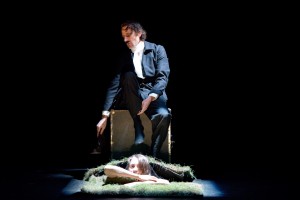Red-Eye to Havre de Grace: Edgar Allan Poe’s Voyage into Madness and Death

Red-Eye to Havre de Grace resembles a story that might have been written by Edgar Allen Poe, dealing as it does with his mental degeneration and mysterious demise on October 7, 1849. It is particularly ironic that the death of the author considered the inventor of the detective tale has remained unsolved.
The creators of Red-Eye to Havre de Grace archly describe it as an “action opera.” While an interesting show, there is little action – at least in the usual meaning – and comparatively
little singing. It is more dialogue based with Ean Sheehy, as Edgar Allen Poe, speaking most of the lines, assisted by Jeremy Wilhelm in a variety of roles. Sheehy’s remarkable resemblance to Poe brings an element of realism to an unrealistic play.
The show begins with Wilhelm, attired as a park ranger, addressing the audience down front. The bizarre conceit is that he is a contemporary docent at the Edgar Allen Poe National Historic Site who has been requested to fulfill the same function for the 21st century touring company. As the folksy Park Ranger Steve, Wilhelm chatters about his job, the tourists who visit the site, and, of course, Poe whose story he gives a local slant. Although Poe spent much of his adult life in Philadelphia, he was born in Boston, the son of actors.
An anachronistic curtain rises, the mood changes, and Wilhelm sings in an operatic voice, “Conquerer Worm,” a poem by Poe written in 1841 and set to music by his composer David Wilhelm. Though like much of Poe’s work, it is about the inevitability of death, “Conqueror Worm” is set in a theatre with angels as a feverish audience engrossed by the tragedy of Man.
Virginia Poe, beautifully played and choreographed by Sophie Bortolussi, is the poet’s dead wife, best known for the characterization of their deep love in “Annabel Lee.” We see her as a restless ghost who gradually takes possession of Edgar Allen Poe’s mind, growing larger in size as she gains power. Her movement generally accompanies Poe’s sung or recited verses. She first emerges crawling up from the ground like a worm. Later, she climbs on Poe’s lap like the erotic child she was when first they met. In her last scene, she is dressed as a flamenco dancer on stilts. As “El Dorado,” a poem written shortly before Poe’s death is sung in Spanish, the couple dances, Virginia towering over her husband, who seems to shrivel away.
Only four characters are on stage and, of those, only two speak. The fourth is the musician David Wilhelm whose multiple pianos create a variety of moods.
The playing area behind the curtain is practically bare. Only minimal, symbolic, and changeable set pieces are used: planks, chairs, tables, a suitcase, a bed frame, and a miniature lawn. They become doors, ticket windows, hotel lobbies, rooms, and trains. Most of the locales represented by the props have the claustrophobic quality that runs through Poe’s oeuvre.
Like many of the works shown at ArtsEmerson, Red-Eye to Havre de Grace is a devised piece, actually doubly devised, since it involves two companies. The Lucidity Suitcase Intercontinental is, as its name implies, homeless. It is known for its exploration of significant, but little explored events, and use of “rough technology,” i.e. low-tech productions. The second group, Wilhelm BROS. & Co. is composed of the actor-singer Jeremy Wilhelm and his brother David, the composer and multi-instrumentalist.
While the hallucinatory episodes are the most spellbinding, Poe’s train journey supplies much of the exposition and background information. He had planned to travel from Virginia to New York on a lecture tour. However, during a stopover in Maryland apparently at the incongruously named Havre de Grace (Harbor of Grace) he accidentally ends up on the Baltimore train. During the trip, he corresponds with Muddy, his aunt/mother-in-law to whom he is very close. These historic documents give us a sense of Poe’s everyday life and problems as well as his deep unhappiness. In his last letter to her, on the far edge of madness he announces his forthcoming death. He was later found lying on a Baltimore Street wearing shabby clothes that did not belong to him and died in a hospital after several days.
On the whole, Red-Eye to Havre de Grace is well done, interesting to listen to, and often lovely to look at. At times, however, it drags. One hundred minutes without an intermission makes huge demands of both the audience and performers. I would recommend this play for poetry lovers, admirers of Poe, and those with an interest in contemporary art theatre. The company plans to tour this piece widely.
Red-Eye to Havre de Grace played at ArtsEmerson’s Paramount Theatre in Boston from Feb. 13-16, 2014
Created by
Thaddeus Phillips
Jeremy Wilhelm
Geoff Sobelle
David Wilhelm
With
Sophie Bortolussi and Ean Sheehy
Choreography by Sophie Bortolussi
Lighting by Drew Billiau
Sound by Ron Kaplowitz
Costumes by Rosemarie McKelvey
Music by Wilhelm BROS. & Co.
Designed and Directed by Thaddeus Phillips